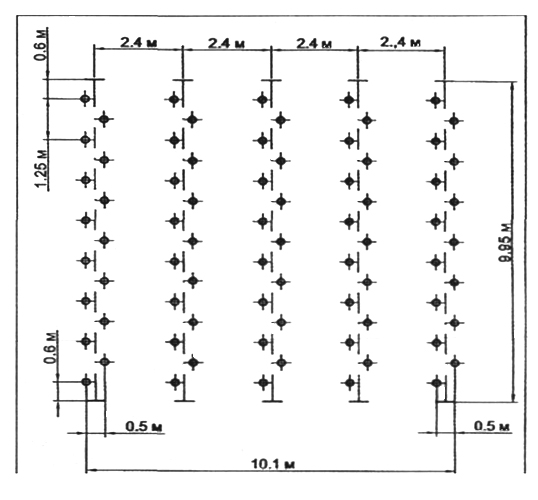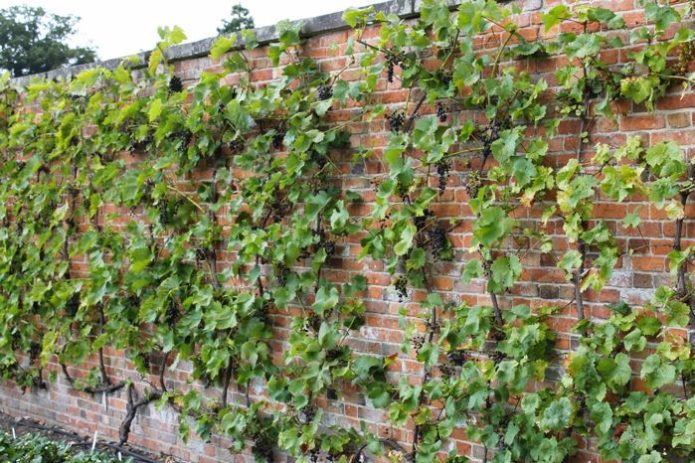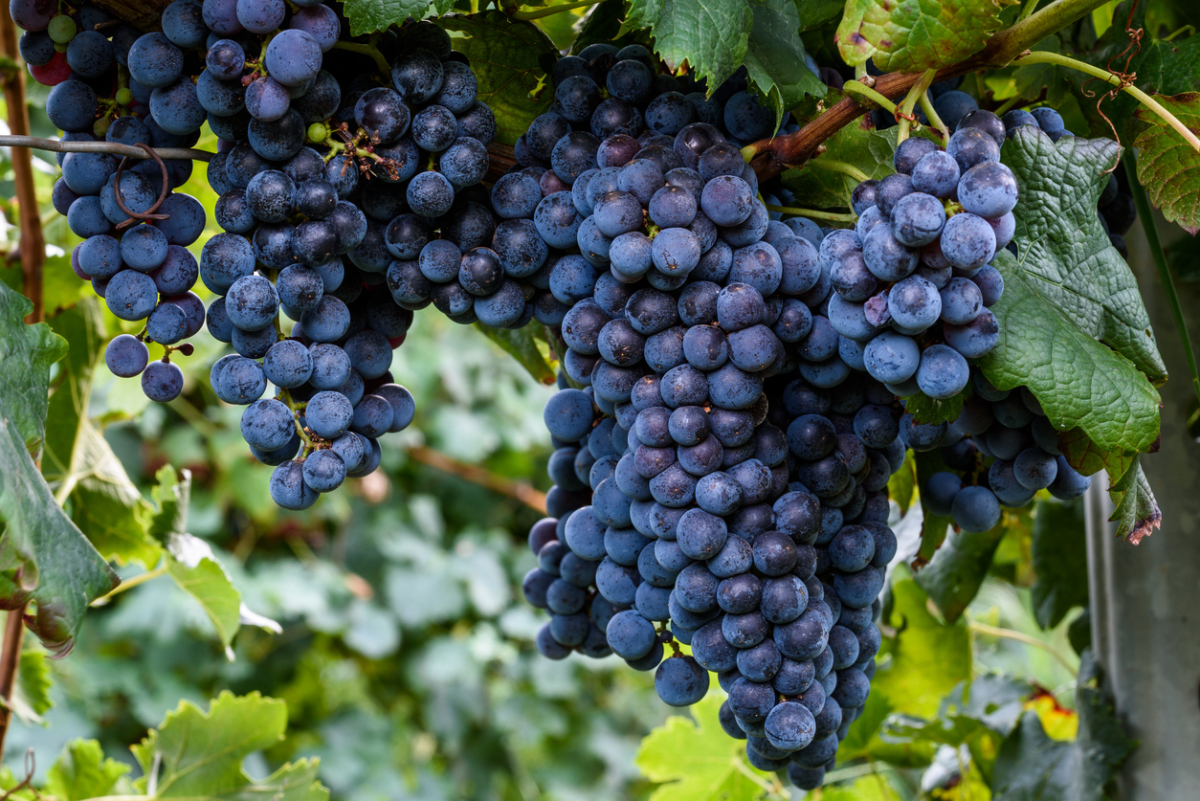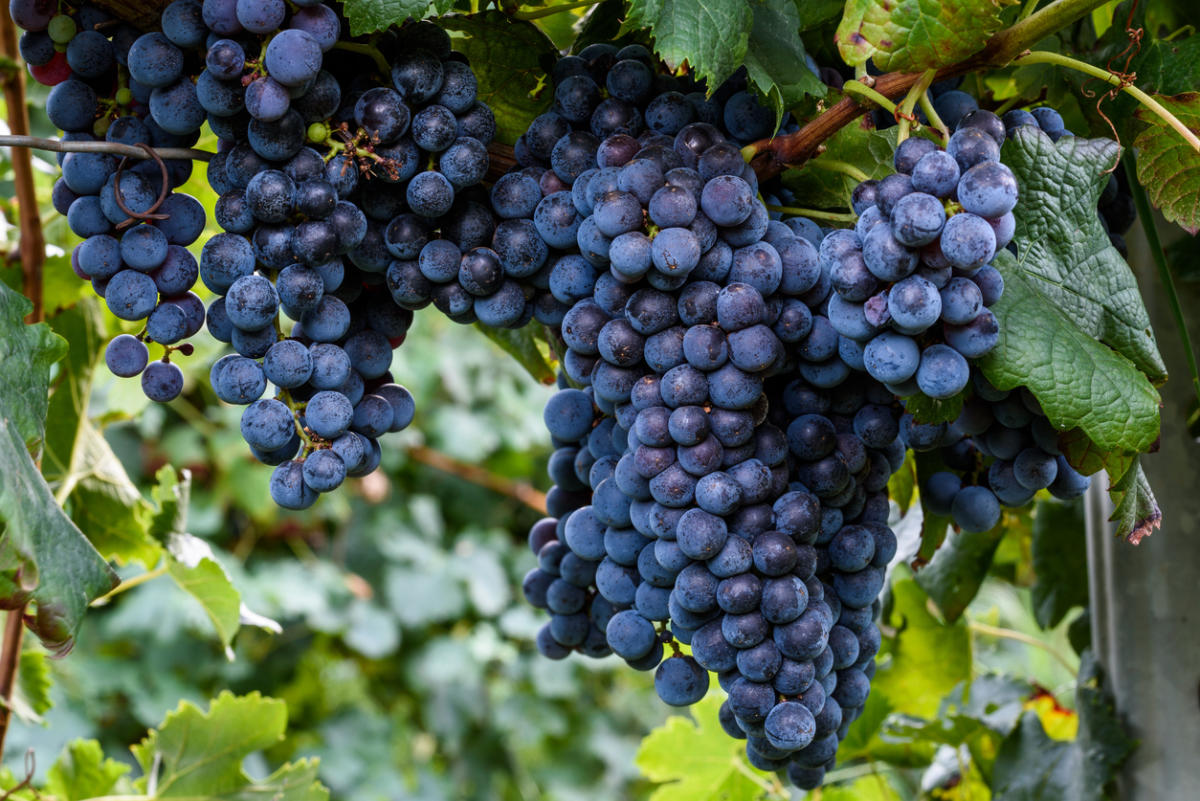Many people love grapes, so they undertake to grow it on their site. Viticulture is an exciting business, but it has many of its own rules and nuances. One cannot do without certain knowledge. One of the first questions that a novice grower might have is the placement of the bushes.
Content
How to arrange grapes on your site
The following factors have a significant impact on the distance between grape bushes in a row and between rows:
- Soil fertility. On fertile soil, the grapes will grow more intensively, so you need to leave more distance to the next bush.
- The magnitude of the growth force of the bushes. If growing a vigorous variety, it is also necessary to leave more distance between the bushes.
- The nature of the alleged grape shaping. The future shape in the horizontal direction (its size, number of arms and their location) is a significant point in determining the spacing between bushes.
- The need to shelter the plant for the winter. Covering viticulture assumes the presence of wide row spacings.
- Trellis construction. Single-lane options require less row spacing than two-lane options.
From the above, it is clear that the grape placement scheme is determined by two parameters - the intervals between the bushes and the row spacing.
There are general recommendations of growers on the layout of plants on the site. It is considered optimal to place the rows from north to south or from east to west, but in practice this advice is not always followed, more often they proceed from the shape of the site, the presence of buildings and other objects on it.
Regarding the layout of the grapes, the recommendations are as follows:
- Row spacing should be greater than or at least equal to the distance between plants in a row.
- For a single-plane trellis, an inter-row distance of up to 2.5 m is sufficient, but not less than 2 m.
- When using two-plane trellises, the optimum distance between them is at least 2.5–3 m.
- From one bush to another in a row, the distance can fluctuate within 1.5–4 m. As a guide, you can take the feeding area required for each bush. It should be at least 5-6 m2.
Recommended grape planting schemes
The growers who are the most scrupulous about the planting scheme can use the existing methods for calculating its parameters for production purposes. For example, on 10.1 m you can place 5 rows of grapes 9.95 m long each with an interval of 2.4 m between them.
In any case, it should be understood that all theoretical recommendations are a skeleton on which to build the muscles of reality.They must be adapted to specific conditions: the characteristics of the microclimate of the site, the composition of the soil, the grape variety, the nature of its upcoming formation.
When planting a culture on your site, one should not forget about the interests of neighbors.
Clause 6.7. SNiP 30-02-97 *, approved by the edition of December 30, 2010 No. 849 "Planning and development of the territory of horticultural (summer cottage) associations of citizens, buildings and structures", states that the minimum distance to the neighboring site should be for the trunks of tall trees - 4 m, medium height - 2 m, shrubs - 1 m.
* SNiP - building codes and regulations.
Regardless of the regulatory legal acts, the grape trellis should not shade the plants beyond the border. In addition, the need to use chemicals to treat grapes can provoke conflict. Experienced viticulture enthusiasts advise not to plant grapes along the northern border with neighbors in general, and with a different arrangement of trellises, retreat about 3 m deep into your site. If the trellis is located perpendicular to the boundary, the extreme bush should be formed only inside its territory. With this solution of the issue, neither the vines nor the roots of the grapes will penetrate the neighbors' plot.
In areas where it is permissible to grow crops without shelter for the winter, bushes are often planted along the walls of buildings, near gazebos, arches, pergolas. This landing has its own nuances.
When planting grapes near the wall of a building or structure, place it at a distance of 1–1.5 m from the foundation so that the roots of the plant do not destroy it, and the walls do not get damp during watering. The culture is brought to the wall using an inclined trellis. At the same time, one should not forget that this is a sun-loving plant, therefore, it should be placed near the wall of the building that is most illuminated during the day.
For vine bushes near the gazebo, arches, pergolas, the following are important:
- lack of nearby competing plants - shrubs and trees;
- location of grapes outside the shadow of buildings and economic facilities.
If these conditions are met, the grapes will not only grow and develop successfully, but also give a good harvest of berries.
Video: grape planting schemes
Table: distance between grapes and objects on the site
| An object | Distance to grapes (m) |
| Foundation of a building or structure | 1–1,5 |
| Mezha | 1–4 |
|
|
| Garden shrubs - raspberries, gooseberries, currants and others | Not less than 2 |
Planting scheme depending on the variety
One of the decisive factors that determine the grape planting scheme is the growth strength of a particular variety:
- vigorous;
- medium-sized;
- undersized.
For vigorous grapes, the shoots of which exceed 2 m, a larger feeding area is required - up to 5-6 m2... Proceeding from this, as well as from the method of further formation of the bush, determine the distance to the neighboring one. So, when forming in one sleeve with a row spacing of 2 m, a distance in a row of 2.5–3 m will be sufficient for vigorous grapes. With two-armed vines formation, when the shoulders of two neighboring bushes will go towards each other, the distance between them should be at least 5-6 m.
A gross violation of the growing conditions necessary for grapes leads not only to a decrease in yield, but also to a loss of fruit quality.
Table: Nutritional areas for different grape varieties
| Grape varieties | Annual growth (m) | Bush feeding area (m2) |
| Vigorous (Delight, Original, Codryanka and the like) | More than 2 | 5–6 |
| Medium-sized (New, Timur, Donetsk pearls and others) | 1,5–2 | 3–4 |
| Weak (Victoria, Bulgaria, Elegant, Early Gourmet and others) | Up to 1 | 1–2 |
Greenhouse grapes
In many regions with cold climates and short summers, grapes are grown in greenhouses. A solid experience of such viticulture has already been accumulated.But this method is also used in the regions of traditional vine growing in the open field, since the greenhouse protects the plant from many adversities - the vagaries of the weather, wasps and other pests, diseases.
In a greenhouse, as evidenced by the practice of viticulture, it is possible even with its small area of 6 m2 plant 3 vines. In this case, the planting scheme is no longer as important as the peculiarities of grape placement. To prevent the plant from getting sunburn, in contact with the walls or roof of the greenhouse, a planting hole or a trench for planting several vines is made at a distance of half a meter from the wall, and the upper wire of the trellis should be at least 0.4 m from the greenhouse roof. Several bushes of grapes in the greenhouse are placed at a distance of 2.5–3 m from each other.
When growing grapes in a greenhouse, the choice of variety is of particular importance. The plant should not be vigorous, prone to the formation of a large number of stepchildren, while in cold regions it is important that its ripening period is not very long. For example, in the Moscow region, the following varieties are recommended for greenhouses:
- Michurinsky;
- Russian corinka;
- Moscow sustainable;
- Northern early.
In the Urals and to the north, preference should be given to grapes:
- Delight is perfect;
- Black Hamburg;
- Bulgaria is stable;
- Foster's white.
Features of planting grapes in different regions
No matter how attractive greenhouse viticulture is, enthusiasts of growing vines in the open field remain in various regions, regardless of the climate. At the same time, the scheme and process of planting grapes undergo the most insignificant changes.
Ural and Siberia
In the Urals and Siberia, summers are short, and winters are long and cold. In the open field, grapes grow slowly, so there are recommendations not to prune it for the first year or two so that the vine gains growth. The varieties are selected for winter-hardy and with a minimum or medium ripening period. Recommended early frost-resistant varieties:
- Li-4;
- Alyoshenkin;
- Early purple;
- In memory of Golikov.
The planting density of bushes also changes - each is given about 1 m for nutrition2, but the depth of the planting pit increases to 1 m. In the trench, the bushes are placed at a distance of 1 m from each other. Of course, in these regions, grapes are harvested for the winter.
Middle zone of Russia
In these places, viticulture began to develop relatively recently thanks to the emergence of new varieties bred by breeders. Such grapes have a short period of fruit ripening and have time to yield a harvest in a short summer. Here it is recommended to plant varieties:
- Augustine;
- Don Agate;
- Alyoshenkin;
- Alexander;
- In memory of Dombkovskaya;
- Rusevn;
- Firstborn of Kuibyshev;
- Ilya Muromets;
- Lucille.
They use the following planting scheme: in a row between bushes 1-3 m, between rows - 2-3 m. Planting depth - no more than 0.4 m.
Moscow suburbs
This region has become a springboard for the movement of grapes to the north. The varieties are grown here ultra-, super- and simply early, otherwise they will not have time to ripen, and having frost resistance up to -35 ° C. The depth of the planting pit, depending on the density of the soil, can be from 0.2 to 0.5 m.It is recommended to leave 2 m between the bushes, and 3 m between the rows.
For many regions
Pink table grapes of the Russian Early variety can be recommended for growing from Ukraine to the Urals, Siberia and the Far East. It winters well at frosts of -23 ° C, that is, in the more southern regions it can be grown without shelter, and in more northern regions - under careful shelter. It is planted in planting pits 80x80 cm, 2 m are left between the bushes.
One of the oldest and most northern grape varieties, Amursky is unpretentious, frost-resistant and perfectly adapts to growing conditions. It can be grown in any natural area. It can be cultivated as a technical one, then when planting, from 0.8 to 1 m is left between the seedlings.To obtain table grapes, this distance is increased to 1.5 m. The distance between rows is 2–2.5 m.
The correct grape planting scheme, correlated with all other parameters of vine growing, can become the key to successful viticulture, subject to further regular plant care in accordance with all the rules of agricultural technology.







